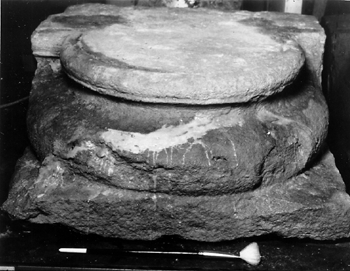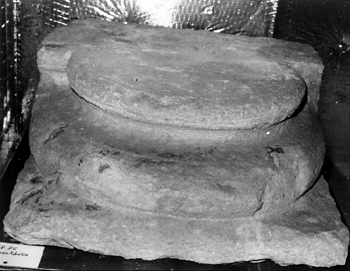OBSERVATIONS ON CYCLODODECANE AS A TEMPORARY CONSOLIDANT FOR STONEREN�E STEIN, JOCELYN KIMMEL, MICHELE MARINCOLA, & FRIEDERIKE KLEMM
6 6. CASE STUDY: TEMPORARY STABILIZATION OF A DOLOMITIC LIMESTONE COLUMN BASEFollowing testing and evaluation of its working properties, cyclododecane was used as a temporary consolidant to permit the safe transport of a large column base in the collection of The Cloisters, of the Metropolitan Museum of Art in New York City. Part of the 12th-century apse from San Martin at Fuentidue�a, Spain, the base measures 62 cm in width and is carved from highly porous dolomite. The yellow dolomite of the apse from San Martin was characterized by Charola et al. (1986) as 90–94% dolomite and 1–5% calcite, with the balance consisting of quartz, illite, and kaolinite. Its porosity ranges from 19% to 27%, and it exhibits bimodal pore-size distribution. The base required consolidation prior to its transport from the museum during storage renovation. The stone surface is dirty and exhibits granular disintegration, flaking, and scaling. Remnants of polychromy are detached and lifting. Numerous deep and shallow fissures extend across the stone surface. Consolidants such as ethyl silicates and acrylics in various solvents were found to be unsuitable for use on test samples of this same stone (Kimmel and Wheeler 1999). Ethyl silicates did not adequately bridge small fissures in the stone. Paraloid B-72 (acrylic copolymer) caused irreversible staining, as did some test applications of DriFilm 104 (silicone resin in mineral spirits), Conservare H (ethyl silicate and methyl-tri-ethoxysilane formulation), and Conservare OH (ethyl silicate). Temporary consolidation with cyclododecane was chosen to stabilize the stone and prevent damage during transport. Melted cyclododecane was applied by brush to cracks and loose stone fragments, forming a thick opaque coating, which cooled on the surface of the object without appreciable penetration. A hot-air gun was directed at the coated surface in an effort to encourage penetration. Direct heat from a hot-air gun applied at a close working distance was found to provide enough heat to force immediate sublimation. The entire surface, including areas with loose remnants of polychromy, was then coated with a saturated solution of cyclododecane in 3 parts Shellsol OMS to 1 part xylenes by volume. This solution was applied with a wash bottle. Shellsol OMS was chosen as the delivery solvent because of its low toxicity. Xylenes were added to increase the concentration of the saturated solution. As noted above, a saturated Shellsol OMS solution is about 80% cyclododecane, and a saturated solution in xylenes is approximately 120% by weight. Upon evaporation of the solvents, a netlike coating of cyclododecane crystals formed on the stone surface (fig. 7). Immediately following treatment, the base was transported to the new storage location.
The cyclododecane provided adequate consolidation and stabilization of the fragile surface, the loose stone and polychromy fragments, and the cracks. No loss or damage to the stone or the polychromy occurred during the move. No tidelines were formed by the consolidant, despite the layer of surface dirt and the susceptibility of this stone to darkening upon conventional treatment. After approximately 10 weeks, the cyclododecane appeared to have departed, leaving no visible traces of the netlike coating or the melted surface layer (fig. 8).
|

